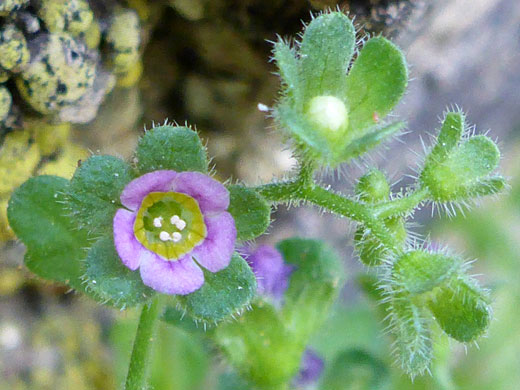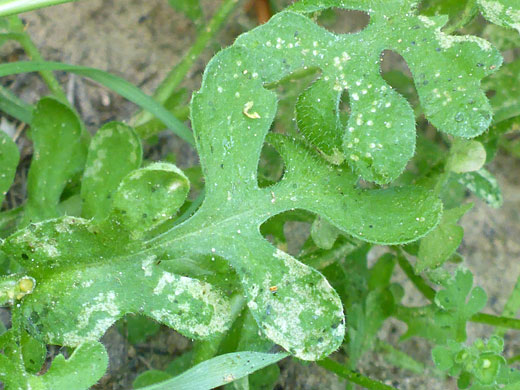Common name:
Desert dainty hideseed
Family:
Scientific name:
Eucrypta micrantha
Main flower color:
Range:
From Nevada and southern California, east to a small area of west Texas
Height:
Up to 10 inches
Habitat:
Plains, washes, canyons, hillsides; most common in desert areas, from near sea level to 8,200 feet
Leaves:
Up to 2 inches long, ovate in outline, deeply divided into broad, rounded-tipped lobes
Season:
March to June
Flowers of eucrypta micrantha can be white, or purple, always with a yellow-green center, and containing five stamens - yellow filaments and white anthers. The corolla is shallowly divided into five lobes. Calyx lobes are broadly ovate in shape, about equal in length to the corolla lobes, with bristly hairs on the undersurfaces. The inflorescence is a branched cluster, of between four and 12 flowers.
Leaves are once pinnately divided into three or four pairs of broad lobes, plus a terminal lobe; margins may have a few small teeth. Leaves are mainly around the base; stem leaves are much reduced, though still lobed. Leaves and stems are also bristly-hairy.
The eucrypta genus, which contains only two species, is a member of the hydrophyllaceae, which has been classed as a separate family but is currently considered to be a subfamily of the boraginaceae.
Leaves are once pinnately divided into three or four pairs of broad lobes, plus a terminal lobe; margins may have a few small teeth. Leaves are mainly around the base; stem leaves are much reduced, though still lobed. Leaves and stems are also bristly-hairy.
The eucrypta genus, which contains only two species, is a member of the hydrophyllaceae, which has been classed as a separate family but is currently considered to be a subfamily of the boraginaceae.
All Contents © Copyright The American Southwest | Comments and Questions | Contribute | Site Map


